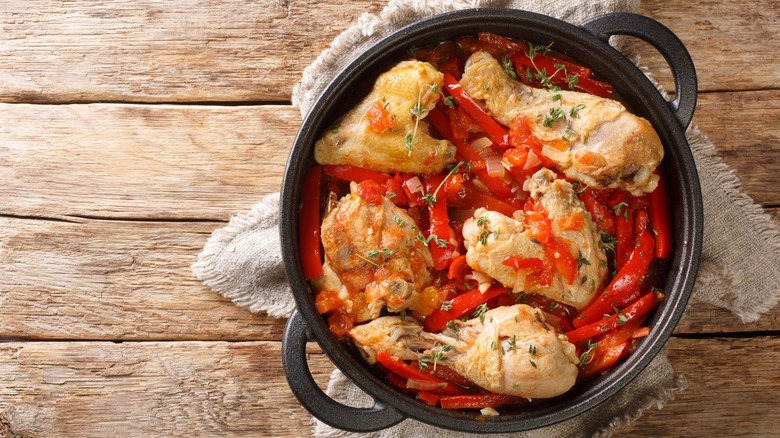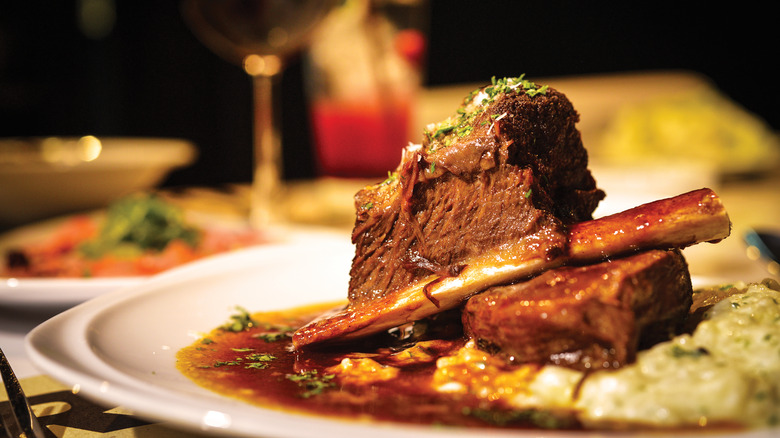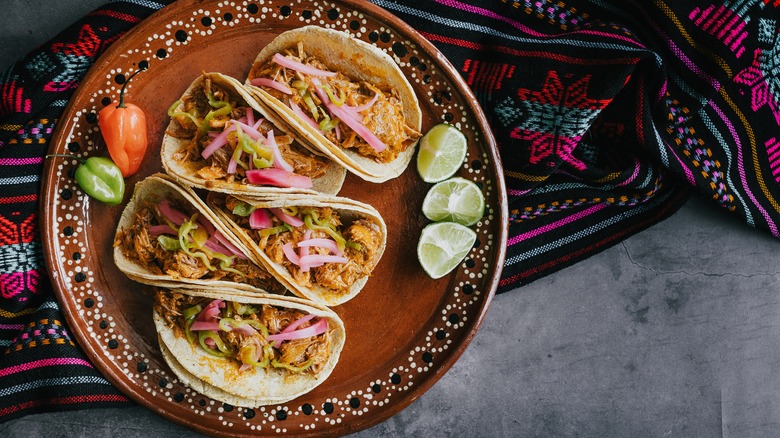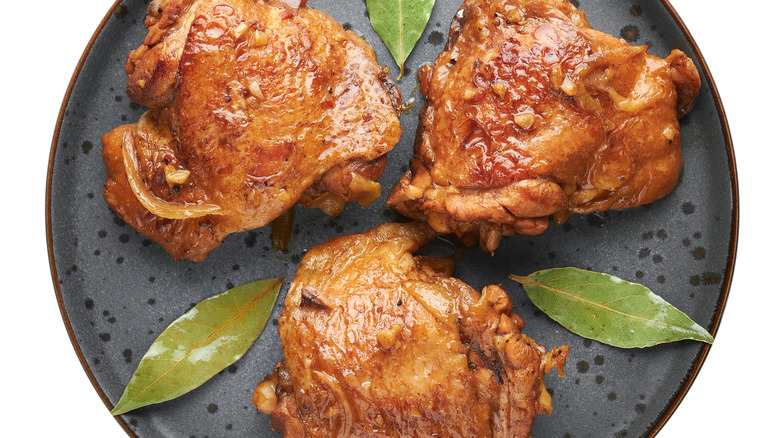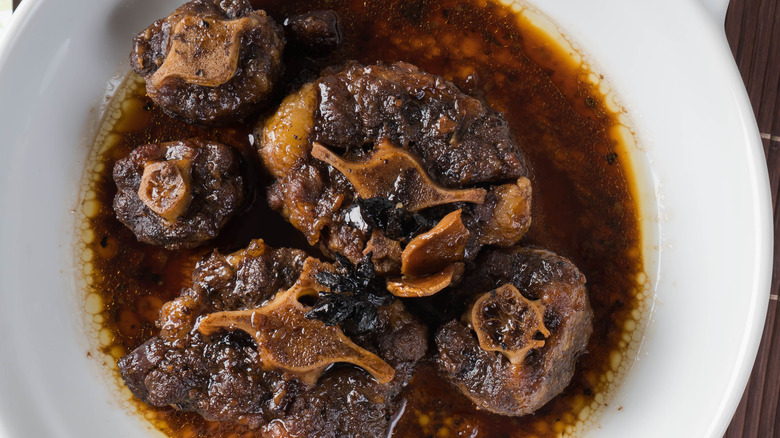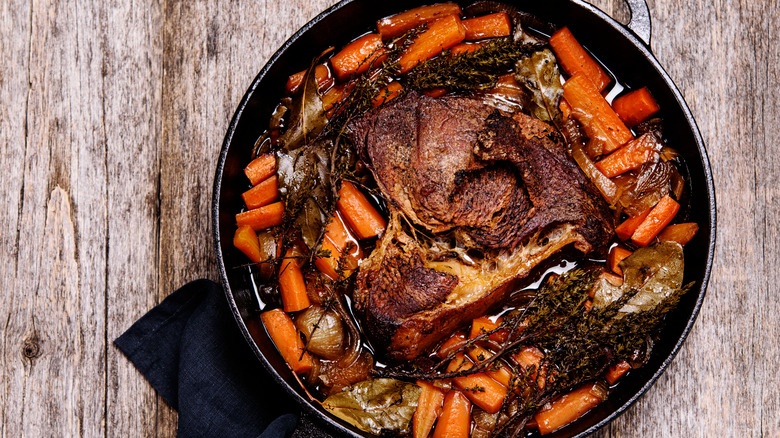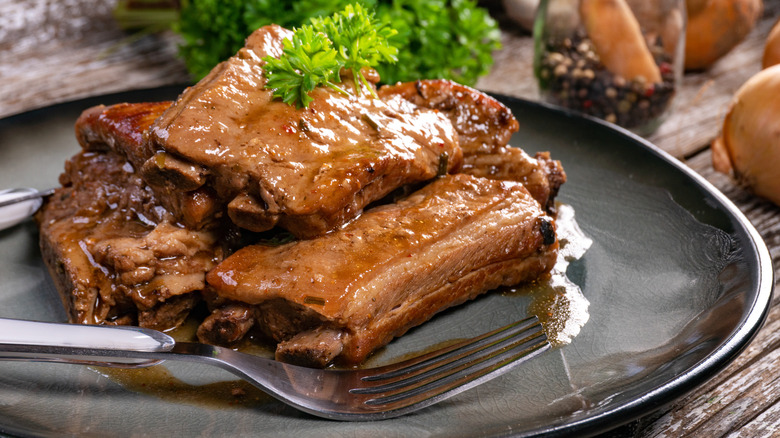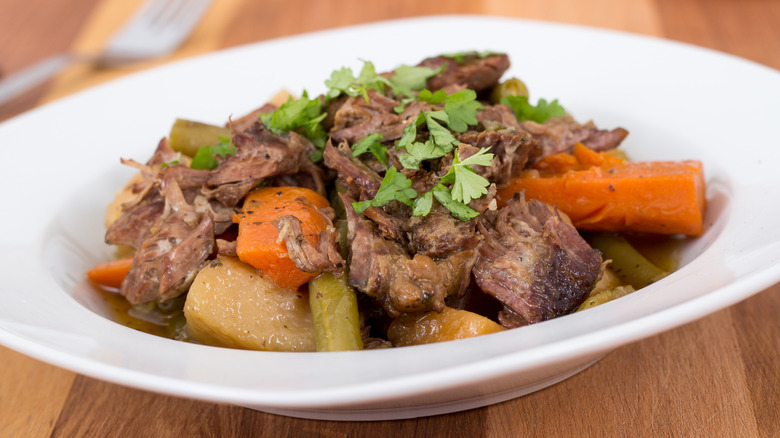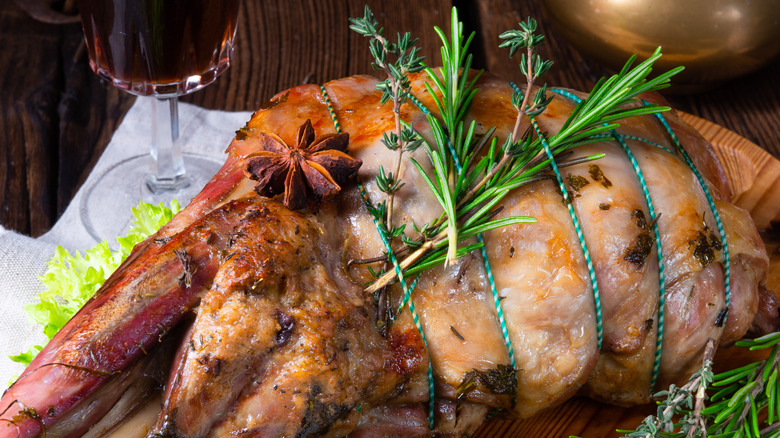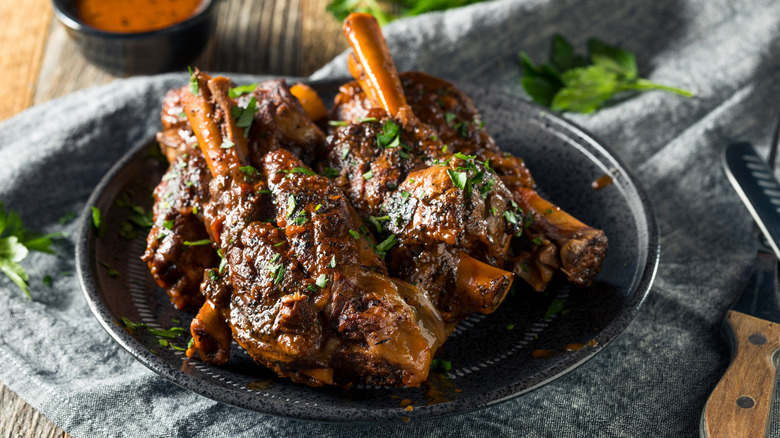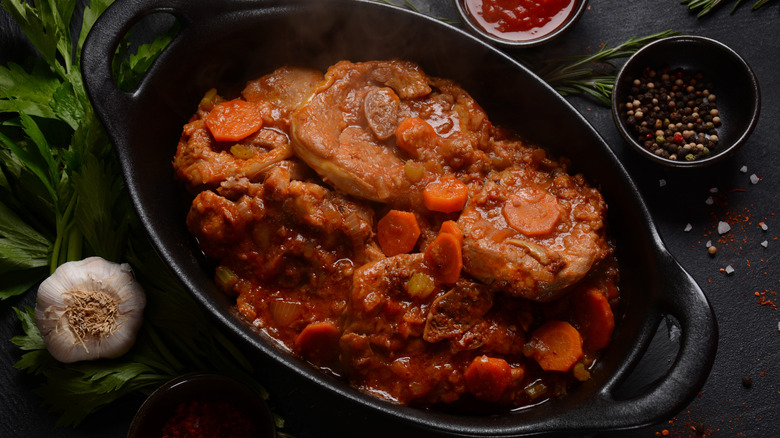The Absolute Best Cuts Of Meat For Braising
To coin a phrase — the best things come to those who wait. A good example of that is the transcendent deliciousness of properly braised meat. When braising meat, home cooks utilize a technique that involves an initial pan-searing, followed by hours-long cooking in hot liquid. The result of a successful braising will turn a once tough main ingredient into something that has become fork tender. Braising is a method most often applied to meat, but cooks can also apply it to hearty vegetables. The best cuts of meat for braising tend to be those with high amounts of collagen and connective tissue.
The long process of braising breaks down what are normally tough tissues, and softens them due to increased moisture. Walk into any butcher section of your local market, and you'll find plenty of cheap cuts with lots of connective tissue that are well-suited to braising. Once their connective tissue is cooked down, these suitable cuts yield highly flavorful meat. With this in mind, you'll want to consider the absolute best cuts of meat for braising.
Beef Short Rib
While other foods may be more popular, braising short rib is perhaps the best example of how the technique can turn a tough cut of meat into something magical. The transcendent nature of a braised short rib has been embraced by celebrity chefs the world over, including Top Chef judge Tom Colicchio.
Counterintuitively, beef short ribs do not come from the rib section of the animal. The rib section is prized for its steak cuts, but because the short rib is full of connective tissue, it does not make for good steaks. Rather, short ribs are included in the chuck section, which comes from the lower neck and upper shoulder. The sinew and fat content are best served with cooking methods that add moisture, which is why braising is perfect for the meat.
The classic approach to short ribs is to braise them in a combination of vegetables, spices, red wine and beef stock. When cooking for President Barack Obama, celebrity chef Marcus Samuelsson used onion, carrot, celery, lemongrass, garlic, ginger, thyme, parsley, plum sauce and horseradish, according to People magazine. A recipe version from celebrity chef Curtis Stone also suggests using white wine instead of red wine (via Nine).
Pork Shoulder
Also known as pork butt, picnic roast, Boston butt, or blade roast — pork shoulder is probably best known as the cut of pork used to make pulled barbecue. Braising pork shoulder to make shredded pork is incredibly easy, but it takes time and is generally considered a day-long cooking affair.
A classic recipe for pork shoulder from Betty Crocker starts by combining paprika, garlic powder, salt, and brown sugar in a bowl. The spice mixture is rubbed on the pork shoulder, and the meat is placed inside a greased slow cooker. Then, ¼ water is poured around the meat, the lid is placed on the slow cooker, and it's all set to cook at low heat for seven to eight hours. Hungry cooks can shred the cooked meat with two forks for an easy and delicious meal.
This classic form of cooked pork can be incredibly versatile. When served in lettuce wraps with kimchi and Korean sauces, it resembles the classic Korean pork dish known as bo ssam (via The Local Palate). Or, when broiled under high heat and served in a tortilla, our carnitas pork recipe can beat even the best Mexican restaurants.
Chicken Thighs
Chicken can get a bad rap for lacking in flavor, but when people level that criticism, they're likely talking about chicken breasts and not chicken thighs. Chicken thighs are so-called 'dark meat' because the thigh muscles of these birds get heavy use; more use than muscles in the upper body. As a result, thigh muscles get more blood flow, resulting in thigh meat having a darker coloration and more flavor. Regular use of the thigh also produces higher amounts of collagen, which is why braised chicken thighs are an ideal way to practice your technique (and craft a delicious meal).
One of the simplest and most flavorful dishes with braised chicken thighs is chicken adobo. Considered a national dish of the Philippines, chicken adobo is a stew of vinegar, soy sauce, peppercorns, garlic, and bay leaves. Like any popular national dish, there are variations associated with different regions (via Yummy.ph). In the Southern Luzon region, the dish commonly includes coconut milk and coconut meat. Adobo from the Cavite region is associated with turmeric. The Bicol region is known for adding coconut milk and chilies to various dishes, including chicken adobo.
Oxtail
Once regarded as an ancillary product by the American meat industry, oxtails have long been a staple in rustic dishes from around the world, from Jamaica to the Philippines. Recently, however, American cooks are learning more about what oxtail really is. They are becoming prized in our national food culture for their ability to transform stews into rich and soulful experiences.
Oxtails may have once come from oxen, but now they typically come from cattle. The cut is butchered from the tail, where a significant amount of collagen is located. Cook's Illustrated writes that when hours of low heat are applied, the collagen turns into gelatin, giving the braising liquid a thick, silky texture and releasing flavorful meat from the bone.
A classic Jamaican-style oxtail stew often includes ingredients such as Worcestershire sauce, carrots and celery, onion, garlic, beef stock, and herbs. After giving the meat a spice rub, browning it, and sweating out the vegetables, the stock is added, and the stew is left to cook for at least three hours. Some people find that the resulting oxtail stew is too oily, but if this is the case, you can skim off excess fat or soak it up using a paper towel.
Point-Cut Brisket
Brisket is a cut of beef that is probably more associated with barbecue than braising, but when cooking brisket, braising it correctly can yield incredible flavor, if at least a different texture. It's important to note that there are two main cuts of brisket: flat-cut and point-cut (via Char-Broil Grills). Also called the first cut, flat-cut brisket is the leanest cut of brisket, and this cut is ideal for people who like to avoid fatty pieces of meat. Point-cut, or second cut, brisket contains more marbled fat, and braising this style makes it extremely succulent. Whole briskets with both pieces are available, and these should be trimmed of excess fat and tissue before cooking.
One recipe for Jewish-style holiday brisket includes shallots, carrots, garlic, ketchup, red wine, and vegetable broth (via Jamie Geller). After being braised for eight hours, the meat is removed, allowed to cool, and sliced against the grain. The slices are then placed back in the cooking pot to reheat before serving. Overall, braising your brisket will yield a quicker meal than what is normally recommended for smoking this cut of meat, and with less mess or equipment necessary.
Pork Spare Ribs
Maybe it's because they're fairly meaty, but spare ribs are considered by many to be the most popular kind of pork rib (via BBQ Champs). It's important to note that there are differences between spare ribs and baby back ribs, with the spares being curved and shorter. Pork spare ribs are a cut from the lower side of the pig, near the belly. Bone marrow is visible on one end of the ribs; the other tapered end is meatier and contains a significant amount of cartilage. Spare rib meat also tends to have significant marbling (intramuscular fat). These qualities require longer cooking times, which is why the cut is ideal for braising.
There are many ways to braise pork spare ribs, and one unique preparation involves cooking them in dark beer (via CraftBeering). First, the ribs should be patted dry, and the membrane removed. Next, the ribs are trimmed and cut into three or four-rib sections. The ribs are then braised with carrots, celery, garlic, tomato paste, beef stock, and a brown beer — such as a Schwarzbier or porter. After about three hours of braising, the meat and veggies can be removed from the pot, and with cornstarch added, the liquid can be reduced into a gravy.
Chuck Roast
Coming from the shoulder area of the animal, chuck roast is an extremely popular cut for braising and probably most associated with slow cooker pot roast. In fact, it's common for supermarkets to label chuck roast as "pot roast." While it's common to see a bone-in version of chuck roast, boneless cuts are easier to work with (via US Wellness Meats).
Ginger snap cookies are one secret ingredient that'll change your pot roast and give a unique spin to dinner. It might sound random, even unappetizing, but adding ginger snaps to pot roast is a German tradition associated with sauerbraten. Adding these slightly sugary, slightly spiced snaps at the end of the braise makes the classic American stew thicker and slightly sweeter.
Easy to pull off and made with common ingredients, pot roast is as American as McDonald's apple pie. One recipe from chef Carrie Forrest, featured by US Wellness Meats, includes potatoes, celery, carrots, onion, steak seasoning, and beef or chicken broth. After about seven to nine hours of braising, the pot roast should shred with little-to-no effort. This hearty meal will easily fill your bowl and your belly.
Lamb Shoulder
You may think of sheep as a wool-producing animal and lamb as a food source, but they're actually one and the same. Technically speaking, a lamb is a sheep that is less than one year old. Coming from exactly where you would expect it to, lamb shoulder contains muscles that get a heavy workload from the animal. The result is a tough but flavorful cut of lamb meat that lends itself well to braising. Even better, shoulder tends to be one of the least expensive and best cuts of lamb.
Lamb shoulder is a bone-in cut, and the meat should be cooked while still attached to the bone. Typically, leaving a piece of meat bone-in will increase the moisture available to the meat — already something we intend when braising. A recipe for oven-braised lamb shoulder from the University of Notre Dame involves cooking the lamb with carrots, celery, onion, garlic, whole tomatoes, thyme, and peppercorns in red wine and chicken stock. The mix of ingredients will become fork-tender and full of sultry, savory flavors that are slightly gamey and fully flavorful.
Lamb Shank
Lamb meat tends to be more expensive than beef or chicken (via Price of Meat). One way to enjoy this delicious type of meat without splurging is to go for a cheaper cut, such as the lamb shank.
Lamb shank is a cut from the bottom front of the animal's leg. It may be available as two different cuts — the foreshank and the hindshank — but they can be used interchangeably. Having a lot of connective tissue, the shank is a tough cut of meat, and this is why it tends to cost less money than other cuts from the same animal. Shank requires low-and-slow heat to become tender, and so braising can turn a lamb shank into something glorious.
Lamb shank has a significant gamey flavor that some people don't enjoy. The best lamb shank recipes pair this gaminess with robust aromatics like garlic, ginger, fennel, or rosemary. Finishing the dish with something bold, such as a mint puree and chopped scallions, can be a common and easy way to both mask, or accentuate, the minerality of the cut. Although the flavor is distinct, braising leaves a soft and shreddable texture that is incomparable.
Center-Cut Beef Shank
The center-cut beef shank is essentially a cross-section of the animal's upper leg and contains a hard-working muscle wrapped around a large marrow bone. This combination makes the center-cut shank ideal for braising.
The fat content of beef shank is quite low, about 1 ounce of fat per pound of shank (via The Online Grill). For those looking to optimize the protein-to-fat ratio of their meat, a beef shank is an ideal cut. For those who aren't concerned, this means a dish with beef shank will call out for added fat and heartier ingredients. Perhaps these extra little considerations are the reasons why center-cut shank is one of the more affordable cuts of beef.
Made with veal or beef, the iconic Osso Bucco dish of Northern Italy exemplifies the ideal way to braise shank. Recipes often call for savory and rich ingredients such as butter and white wine, along with robust additions of minced garlic, onion, carrots, diced tomatoes, and beef stock as the braising liquid. After braising the meat for four to five hours, it should be tender enough to fall off the bone. The traditional way to serve this hearty stew is over creamy polenta. Osso Bucco is as warming to the stomach as it is to the soul, and it all comes from braising.
